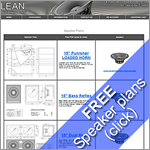LEAN AUDIO No.1 for PA Loudspeakers, Guitar Speakers, Bass Guitar Speakers & HI FI speakers
- Home
- Categories
- * Deals of the Month
- MONTAGE Guitar Cabinets
- Loudspeaker Design Books
- Linea Research Amplification and DSP
- WGS Guitar Speakers
- 18 Sound Loudspeakers
- Celestion Bass Guitar Speakers
- Celestion Guitar Speakers
-
Celestion PA Speakers
- Celestion 1" Compression Drivers
- Celestion 1.4 Compression Driver
- Celestion 2" Compression Drivers
- Celestion PA Horn Flares
- Celestion 2" to 8" PA Speakers
- Celestion 10" PA Speakers
- Celestion 12" PA Speakers
- Celestion 15" PA Speakers
- Celestion 18" PA Speakers
- Celestion 21" PA Speakers
- Celestion Coaxial Speakers
- Celestion Speaker Kits
- Eminence Bass Guitar Speakers
- Eminence Guitar Speakers
- Eminence PA Speakers
-
BMS PA Loudspeakers
- BMS 1" Compression Drivers
- BMS 1.4" Compression Drivers
- BMS 2" Compression Drivers
- BMS 5" PA Speakers
- BMS 6" PA Speakers
- BMS 8" PA Speakers
- BMS 10" PA Speakers
- BMS 12" PA Speakers
- BMS 15" PA Speakers
- BMS 18" PA Speakers
- BMS Triaxial PA Speakers
- BMS Planar Drivers
- BMS Diaphragms
- BMS RECONE KITS
- BMS Horns and Flares
- BMS Coaxial Crossover
-
SB Audience
- SB Audience 1" Compression Drivers
- SB Audience 1.4" Compression Drivers
- SB Audience 1" to 5" Loudspeakers
- SB Audience 6" Loudspeakers
- SB Audience 8" Loudspeakers
- SB Audience 10" Loudspeakers
- SB Audience 12" Loudspeakers
- SB Audience 15" Loudspeakers
- SB Audience 18" Loudspeakers
- SB Audience 21" Loudspeakers
- SB Audience Horns & Flares
-
FaitalPRO, PA & Bass Speakers
- 3" FaitalPRO FE Speakers
- 4" FaitalPRO Speakers
- 5" FaitalPRO Speakers
- 6" FaitalPRO Speakers
- 8" FaitalPRO Speakers
- 10" FaitalPRO Speakers
- 12" FaitalPRO Speakers
- 15" FaitalPRO Speakers
- 18" FaitalPRO Speakers
- FaitalPRO Horns and Waveguides
- 1" FaitalPRO Compression Drivers
- 1.4" FaitalPRO Comp Drivers
- 2" FaitalPRO Compression Drivers
- RCF PA Loudspeakers
- KEF Subwoofers
- KEF Headphones Hi-Fi, iPod iPad
- KEF In-Ceiling Speakers
- KEF In-Wall Speakers
- KEF Outdoor Speakers
- KEF HIFI & AV Speakers
- Chord Speaker Cables
- HOODY Fire and Speaker hoods
- B&C PA and Bass Loudspeakers
- Precision Devices Loudspeakers
- Cerwin Vega PA Amplifiers
- CIARE PA Loudspeakers
- EVM & PRO Guitar Speakers
- Cerwin Vega Speakers
- Tayden Guitar Speakers
- LD PA Speakers & Systems
- Matrix Amplifiers
- Guitar Speaker Diffuser's
-
SB Acoustics
- SB Acoustics AMT Tweeter
- SB Acoustics 14mm Dome Tweeters
- SB Acoustics 19mm Dome Tweeters
- SB Acoustics 21mm Dome Tweeters
- SB Acoustics 26mm Dome Tweeters
- SB Acoustics 29mm Dome Tweeters
- SB Acoustics 21mm Ring Radiators
- SB Acoustics 29mm Ring Radiators
- SB Acoustics Filler Drivers
- SB Acoustics 1" Widebanders
- SB Acoustics 2.5" Widebanders
- SB Acoustics 3" Widebanders
- SB Acoustics 4" Loudspeakers
- SB Acoustics 5" Loudspeakers
- SB Acoustics 5x8" Loudspeakers
- SB Acoustics 6" & 6.5" Loudspeakers
- SB Acoustics 7.5" Loudspeakers
- SB Acoustics 8" Loudspeakers
- SB Acoustics 9.5" Loudspeakers
- SB Acoustics 10" Loudspeakers
- SB Acoustics 12" Loudspeakers
- SB Acoustics 15" Loudspeakers
- SB Acoustics Coaxial Loudspeakers
- SB Acoustics Passive Radiators
- PALMER Guitar Effects and Audio Tools
- Vaugnh Skow Guitar Pickups
- Spares - Celestion
- Stuff (Accessories etc.)
- FANE ACOUSTICS Guitar Speakers
- Guitar & Bass: Amps Cabs Combos
- MAGIC Harmonica Amplifiers
- Lazy J Guitar Amps, Cabinets and Merchandise
- Information
- Contact Us
- My Account
- Shopping Cart
Suppliers of KEF, Eminence, 18 Sound, Celestion, Tayden, Ciare, Montage, WGS, Faital Pro, RCF, B&C, Matrix & Palmer
Categories
* Deals of the Month ---------------------------- MONTAGE Guitar Cabinets ---------------------------- Loudspeaker Design Books ---------------------------- Linea Research Amplification and DSP ---------------------------- WGS Guitar Speakers ---------------------------- 18 Sound Loudspeakers ---------------------------- Celestion Bass Guitar Speakers ---------------------------- Celestion Guitar Speakers ---------------------------- Celestion PA Speakers ---------------------------- Eminence Bass Guitar Speakers ---------------------------- Eminence Guitar Speakers ---------------------------- Eminence PA Speakers ---------------------------- BMS PA Loudspeakers ---------------------------- SB Audience ---------------------------- FaitalPRO, PA & Bass Speakers ---------------------------- RCF PA Loudspeakers ---------------------------- KEF Subwoofers ---------------------------- KEF Headphones Hi-Fi, iPod iPad ---------------------------- KEF In-Ceiling Speakers ---------------------------- KEF In-Wall Speakers ---------------------------- KEF Outdoor Speakers ---------------------------- KEF HIFI & AV Speakers ---------------------------- Chord Speaker Cables ---------------------------- HOODY Fire and Speaker hoods ---------------------------- B&C PA and Bass Loudspeakers ---------------------------- Precision Devices Loudspeakers ---------------------------- Cerwin Vega PA Amplifiers ---------------------------- CIARE PA Loudspeakers ---------------------------- EVM & PRO Guitar Speakers ---------------------------- Cerwin Vega Speakers ---------------------------- Tayden Guitar Speakers ---------------------------- LD PA Speakers & Systems ---------------------------- Matrix Amplifiers ---------------------------- Guitar Speaker Diffuser's ---------------------------- SB Acoustics ---------------------------- PALMER Guitar Effects and Audio Tools ---------------------------- Vaugnh Skow Guitar Pickups ---------------------------- Spares - Celestion ---------------------------- Stuff (Accessories etc.) ---------------------------- FANE ACOUSTICS Guitar Speakers ---------------------------- Guitar & Bass: Amps Cabs Combos ---------------------------- MAGIC Harmonica Amplifiers ---------------------------- Lazy J Guitar Amps, Cabinets and Merchandise ---------------------------- All Products ... |
Home ::
LD PA Speakers & Systems ::
DAVE Portable PA Systems ::
LD Systems DAVE 12 Portable Active PA System 12"
|
Guitar Speakers, Pa Loudspeakers, Bass Guitar Speakers, Subwoofer, Hifi Speakers, in Ceiling SpeakersInformationTrustPilot Reviews |
|
Email: [email protected] Tel: +44 (0)1473 744089
|
Copyright
© 2023 Lean Business Audio Limited. Lean Business Audio is a Limited company registered in England and Wales. Registered number: 04991687. 18 The Sterling Complex, Farthing Road Industrial Estate, Ipswich, IP1 5AP. |




